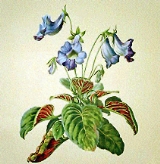
Sinningia speciosa
Encyclopedia
Sinningia speciosa, commonly known in the horticultural trade as Gloxinia, is a tuberous member of the flowering plant
family Gesneriaceae
. The common name has persisted since its original introduction to cultivation from Brazil
in 1817 as Gloxinia speciosa. The name Florist's gloxinia is sometimes used to distinguish it from the rhizomatous species now included in the genus Gloxinia
. The plants produce large, velvety, brightly colored flowers and are popular houseplants. Cultural requirements are similar to those of African Violets except that S. speciosa generally requires more light and often has a dormant period, when the tuber should be kept cool and dry until it resprouts.
Flowering plant
The flowering plants , also known as Angiospermae or Magnoliophyta, are the most diverse group of land plants. Angiosperms are seed-producing plants like the gymnosperms and can be distinguished from the gymnosperms by a series of synapomorphies...
family Gesneriaceae
Gesneriaceae
Gesneriaceae is a family of flowering plants consisting of ca. 150 genera and ca. 3,200 species in the Old World and New World tropics and subtropics, with a very small number extending to temperate areas. Many species have colorful and showy flowers and are cultivated as ornamental plants.Most...
. The common name has persisted since its original introduction to cultivation from Brazil
Brazil
Brazil , officially the Federative Republic of Brazil , is the largest country in South America. It is the world's fifth largest country, both by geographical area and by population with over 192 million people...
in 1817 as Gloxinia speciosa. The name Florist's gloxinia is sometimes used to distinguish it from the rhizomatous species now included in the genus Gloxinia
Gloxinia
Gloxinia can refer to:*The genus Gloxinia of flowering plants in the family Gesneriaceae*The plant species Sinningia speciosa, formerly classified in the genus Gloxinia and still commonly known by that name, in the family Gesneriaceae...
. The plants produce large, velvety, brightly colored flowers and are popular houseplants. Cultural requirements are similar to those of African Violets except that S. speciosa generally requires more light and often has a dormant period, when the tuber should be kept cool and dry until it resprouts.

